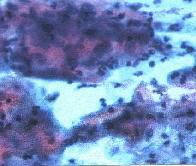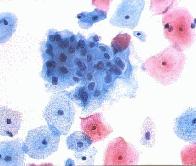 |  |
| Conventional Pap Smear slide | ThinPrep Pap Test slide |
The Pap test is the method used for screening for cervical cancer. The test involves the doctor scraping the patient’s uterine cervix, then smearing the cells collected onto a microscope slide for review by a laboratory.
Since its introduction 50 years ago by Dr. George Papanicolaou, the Pap test has been an amazing success, dramatically reducing the annual number of cervical cancer deaths from 35,000 or more in the 1940s to less than 5,000 today.
Today we know that all women 18 years old and older should visit their physicians and have a Pap test done once a year, as should those under 18 who are sexually active.
Despite the success of the traditional Pap test, it is far from a perfect screening tool for cervical cancer. The accuracy of the traditional test has always been limited by the procedure used to collect and process the cells from your cervix. Specifically, it appears that the “smearing” of cells on a slide causes uneven layering, crowding and overlapping of cells, making it difficult to see all the cells. Excessive blood and mucous on the slide may also cover up many of the diagnostically important cells.
A new automated laboratory instrument, the ThinPrep Processor, has been developed to improve the processing of cells from your Pap test. Instead of smearing the sample, the doctor rinses the collection device containing your cervical sample into a vial of preservative solution and sends the vial to the lab. The ThinPrep Processor automatically places a thin layer of cells on the microscope slide, minimizes cell overlapping, and removes obscuring blood and mucous. The improved quality of the slide makes it easier to see the slide to make an accurate diagnosis and should reduce the need for unnecessary repeat testing.
In clinical trials with thousands of cases studied at leading hospitals comparing ThinPrep Pap tests to traditional smears, doctors found the ThinPrep Pap tests to be more sensitive for the detection of cervical cancer or pre-cancerous conditions. Biopsies (tissue samples taken to verify Pap test diagnoses) confirmed their findings. Specifically, the ThinPrep Pap test improved the detection of abnormal cells by 65% and reduced the number of inadequate specimens by more than 50%. Perhaps most importantly, the number of false negative diagnoses (a diagnosis of normal when, in fact, disease is present) was reduced by 4 to 1.
 |  |
| Conventional Pap Smear slide | ThinPrep Pap Test slide |
ThinPrep Pap testing represents the first significant advance in cervical cancer screening technique since the development of the traditional Pap test 50 years ago. It was approved by the FDA in May of 1996, but did not gain immediate widespread use because many insurers would not cover the marginal increase in cost over traditional testing. Fortunately, this trend seems to be changing as many insurers in our area are beginning to provide coverage for ThinPrep testing.
We are pleased to offer our patients this improved Pap test technology. Please check with your insurance regarding coverage for ThinPrep testing.
Drs. Bettini, Emery, Hodges, Anderson,
and Christine Pintz, RN, CNP